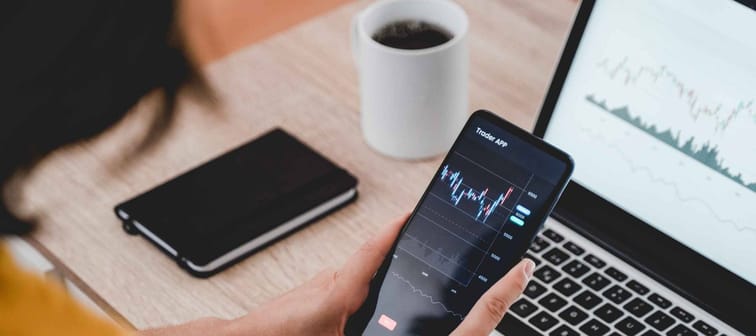How to start mining crypto in under 60 seconds
We’re going to start mining using the service NiceHash. You’re going to have lots of questions as we go, but I’ll answer those in the sections below.
To start, let’s head to the NiceHash Profitability Calculator and click “get started.”

Next, create an account:

Once you verify your email address and log back in, NiceHash will ask you to “select services”: open a crypto wallet, start mining or both. I recommend choosing both:

From the main NiceHash dashboard, connect your “rig” (aka computer):

Choose the mining software that matches your GPU. If you’re unsure what GPU you have, follow the path Start > DXDiag > Display 1 tab on Windows, or Apple > About This Mac.

Log in once the NiceHash desktop app is downloaded.

Finally, click “Start Mining.”

Congrats! You’re now a bitcoin miner. How easy is that?
From here on out, anytime you want to earn some side income by mining, you can just open the NiceHash dashboard and click “Start Mining.”
Your earnings are automatically deposited into your NiceHash crypto wallet where you can hold them as long as you feel like staying invested in bitcoin.
But if you ever choose to cash out on your mined crypto, you can go to your NiceHash dashboard > Wallet > Deposit and enter your cryptocurrency wallet info. Then you can sell your mined bitcoin just like regular bitcoin on your preferred crypto trading platform.
More: Best crypto exchanges
There you have it — you’ve started mining bitcoin in under 60 seconds. Next time you’re trying to make friends in a hostel in Seoul, you can impress everyone by telling them you’re a profitable bitcoin miner!
Now that you’re a bitcoin miner, let’s talk about what exactly is going on behind the scenes. What is mining? How much will you earn? And, oh yeah, will it affect your power bill?
Meet Your Retirement Goals Effortlessly
The road to retirement may seem long, but with WiserAdvisor, you can find a trusted partner to guide you every step of the way
WiserAdvisor matches you with vetted financial advisors that offer personalized advice to help you to make the right choices, invest wisely, and secure the retirement you've always dreamed of. Start planning early, and get your retirement mapped out today.
Get StartedWhat is bitcoin mining?
To understand bitcoin mining, you first need to understand how the blockchain works.
The blockchain is like a giant online ledger — a permanent record of all the crypto transactions in the world, as well as other types of data.
The mysterious Satoshi Nakamoto launched the first blockchain in 2009 and created Bitcoin as a way to demonstrate how the blockchain worked. Interestingly, although he titled his original 2008 whitepaper “Bitcoin: A Peer-to-Peer Electronic Cash System,” Nakamoto never once mentions the term “bitcoin” again; the rest is focused on how blockchain works.
When you send or receive bitcoin (or other cryptocurrency), computers across the world validate your transaction and record all the details of it on the blockchain, i.e., the ledger. That record includes key data like the amount transferred, the date and time, sender and recipient, and more.
There are two key factors that make blockchain so compelling.
First, all data recorded on the blockchain is permanent — figuratively speaking it’s etched in stone. It’s also viewable by anyone with the right software, which is how the IRS has started busting people who don’t report their crypto gains on their taxes.
More: Tax guide to cryptocurrency investments
Second, the blockchain is decentralized; no one entity owns or controls the blockchain. That’s why investors and crypto fans love it so much, and many consider it to be the future of wealth storage. The blockchain can’t be directly influenced by a bank, corporation or government. It simply exists, free of bias or hidden agendas.
But how is the data added to the blockchain? The answer is the bitcoin miners do it.
How bitcoin mining works
Bitcoin mining is the process of dedicating computing power to maintaining the blockchain and validating crypto transactions.
To draw an analogy, these rows and rows of computers in giant, commercial bitcoin mines are like the rows of clerks and accountants at Gringotts Bank in Harry Potter, carefully documenting each and every sensitive financial transaction to keep the records straight.
Han’s bitcoin mining operation wasn’t quite so complex, but it was financially successful nonetheless. So how do miners like him make money?
The amount of resources it takes to mine Bitcoin is extremely expensive — a single “mine” can have millions of dollars worth of computer hardware, expensive graphics cards, power and cooling costs, and more.
Satoshi Nakamoto knew he’d have to include an incentive for miners to maintain the blockchain, so for every 1 megabyte of blockchain data your computer processes, you’re rewarded with a tiny trickle of bitcoin.
Presumably, the visual of tiny nuggets of bitcoin coming out of the walls of the blockchain is what gave rise to the term “mining.”
For Nakamoto, the genius concept of mining solved three problems:
- It provided a financial incentive for resourceful people around the world to maintain the blockchain for everyone else.
- It *de-*incentivized anyone from hacking the blockchain. To overwhelm and hack the blockchain, you’d have to amass more combined CPU power than all the computers already working on it. At that point, why not mine it instead of hack it? After all, mining it with that much computer power would generate a staggering amount of wealth.
- Finally, mining provided a means for Nakamoto to control inflation. Carefully limiting and controlling the amount of Bitcoin released into circulation would ensure that the value of a single bitcoin would remain high.
Stop overpaying for home insurance
Home insurance is an essential expense – one that can often be pricey. You can lower your monthly recurring expenses by finding a more economical alternative for home insurance.
SmartFinancial can help you do just that. SmartFinancial’s online marketplace of vetted home insurance providers allows you to quickly shop around for rates from the country’s top insurance companies, and ensure you’re paying the lowest price possible for your home insurance.
Explore better ratesWhen did bitcoin mining go mainstream?
The flaw in Nakamoto’s design, if you could point to one, was that the blockchain grew so big, so fast, that only the biggest bitcoin mines were able to earn any serious money.
In order to record data to the blockchain, Bitcoin accountants (computers) would have to solve an astonishingly complex series of calculations. In order to mine Bitcoin and profit, your computer has to solve the puzzle first.
That’s why the giant mines in China, Russia and Iceland kept getting bigger and bigger. They were vying for pole position, trying to solve computational puzzles faster than the competition and take a bigger share of the newly minted Bitcoin pie.
So if bitcoin mining is this incredibly competitive global arms race, how can you hope to compete from your home office?
Easy: You don’t compete with these mines — you join ’em.
You can lease your computing power to one of these more powerful mines and, in exchange, you get paid in crypto. That’s what we set up above.
The global mining industry has led to a rising demand for a new kind of commodity: computing power. “Renting” or “leasing” some of your computer’s processing power to a big mine is 100% safe, 100% easy and is itself considered a form of mining. After all, your computer is being used to mine crypto, even if you know nothing about blockchain code.
The service we set up today is called NiceHash, and before we dive into the nitty gritty, let’s chat requirements and earnings potential.
What do I need to mine crypto?
Almost any computer can mine crypto, but if you want to earn serious side income doing it, you’ll need a powerful computer.
For reference, my buddy Will mines crypto in 2021 using a gaming computer he built to top-of-the-line specs in 2019. Most notably, he has a powerful graphics card — an Nvidia GeForce RTX 2060 — which handles the brunt of the crypto mining workload.
Will’s setup would be considered still impressive in the gaming world, but in the crypto world, it’s pretty basic. Will lets his computer mine crypto in the background about 23 hours a day, seven days a week, with the occasional break to play games.
As a result, Will’s modestly powerful computer is able to mine $3 to $6 worth of crypto per day.
That may not sound like much, but it adds up quickly. That’s an extra $90 to $180 per month, or up to $2,000 a year in side income — just for letting his computer run an extra process in the background.
Granted, he won’t earn that much forever. As the processing demands of the blockchain increase, the payouts for miners decrease.
That’s why there’s so much competition for both miners and gamers (and gamer/miners like Will) to scoop up the newest graphics cards. Nvidia’s newest GPUs — the RTX 3060, 3070, 3080, and 3090 — are becoming impossible to find and selling for three times their MSRP by greedy scalpers.
And people pay the scalpers’ prices, because a single RTX 3090 graphics card can generate an extra $208.75 per month from mining.
Even if you don’t have a powerful gaming computer loaded with the newest graphics card, it’s entirely possible to still earn a small trickle of bitcoin from mining.
How much can I make mining crypto?
NiceHash has a “profitability calculator” that will estimate how much you can earn mining based on your computer’s specs. You can either let NiceHash scan your computer or input your computer’s hardware specs yourself:

If you’re unsure what CPU or GPU you have, here is how you can find out:
- On Windows: Click Start > type in DXDiag – this will take you to the DirectX Diagnostic tool, where it lists your exact CPU and GPU
- On Mac: Choose Apple > About This Mac. Same thing.
In my case, my work laptop’s CPU is actually powerful enough to profit from mining: $0.14 a day, baby!

GPUs are much more effective than CPUs for mining, so if you have a decent GPU from the last five years, you’ll be able to earn much more than me. For example, here’s how much you could earn with an RTX 1060 from 2016:

In short, you need a gaming graphics card to make any decent money from mining crypto. A top-of-the-line CPU in your work computer won’t be able to earn a tenth of what a GPU from five years ago can earn.
So if you already have a gaming graphics card, congrats! It’ll make a mighty fine pickaxe.
If you don’t have a GPU, is it worth getting one just to mine?
Some say yes; some say no. I think that it’s too much of a gamble.
The first problem that you’ll encounter is that decent GPUs good for mining are hard to find. Prices are currently inflated 50% to 200% on new and used GPUs, meaning it’ll take you longer to pay it off.
And don’t forget that you have to build a functioning computer around it. Between a CPU, case, power supply and the rest of your build, you could be looking at $600+ for a decent mining rig — in addition to the cost of the graphics card.
The final risk is that by the time you get up and running, you won’t turn a profit in time. Your RTX 1060 may earn you $1.81 per day now, but maybe only $1.79 next month and $1.40 next year.
Mining is a no-brainer if you already have a good GPU, but since they’re so expensive these days and payouts are dropping, it’s not worth buying one just to mine.
What are the risks and drawbacks of mining crypto?
There are no security risks involved with leasing your GPU power through a site like NiceHash.
Nor will your computer explode. This was a real concern among early miners — that running their GPUs 24/7 would cause them to overheat and melt their computers.
But gaming graphics cards are made for it. In fact, bitcoin mining is less stressful on them than actual gaming. So using a GPU to mine bitcoin 24/7 is like using a sports car built for the racing track to calmly drive to work — a breeze.
There are two objective drawbacks to mining:
- It slows your computer a bit: My friend Will doesn’t notice any slowdown until he tries to mine and play games or edit videos at the same time. But he mines all day while he emails and works in Google Drive without a performance drop.
- It increases your power bill: Big surprise, running your computer 24/7 hikes up your power bill. But not by much, maybe $5-$10 per month.
The bottom line
Bitcoin mining may not be profitable for everyone, but if you have a powerful enough computer, it’s an effortless way to earn extra cash each month. After all, the safest way to invest in crypto is to get it free!
More: What is blockchain technology and how does it relate to investing?
Sponsored
Follow These Steps if you Want to Retire Early
Secure your financial future with a tailored plan to maximize investments, navigate taxes, and retire comfortably.
Zoe Financial is an online platform that can match you with a network of vetted fiduciary advisors who are evaluated based on their credentials, education, experience, and pricing. The best part? - there is no fee to find an advisor.










